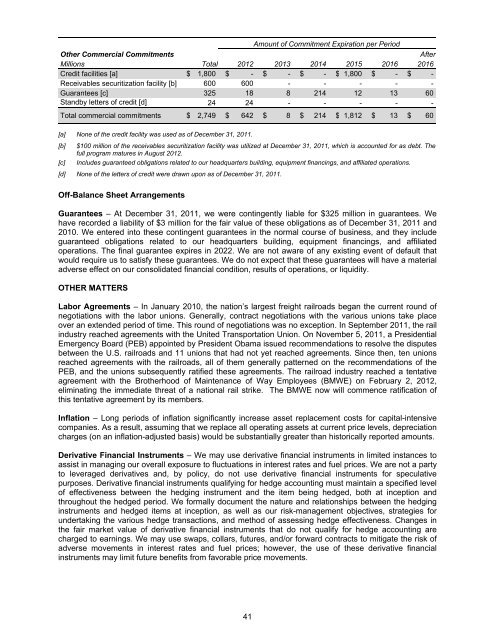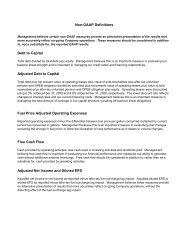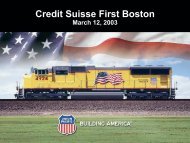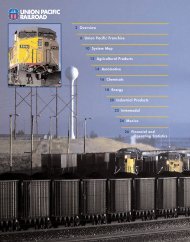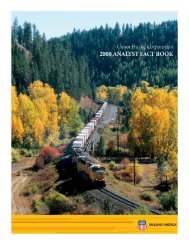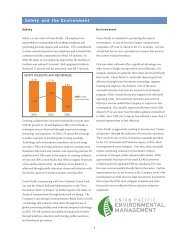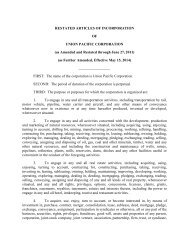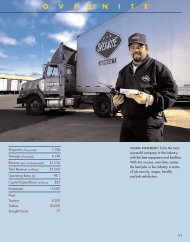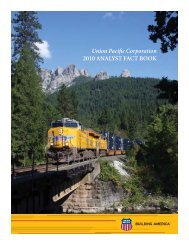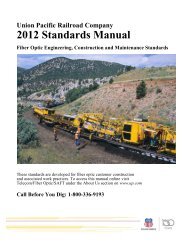Form 10-K - Union Pacific
Form 10-K - Union Pacific
Form 10-K - Union Pacific
Create successful ePaper yourself
Turn your PDF publications into a flip-book with our unique Google optimized e-Paper software.
Amount of Commitment Expiration per Period<br />
Other Commercial Commitments<br />
After<br />
Millions Total 2012 2013 2014 2015 2016 2016<br />
Credit facilities [a] $ 1,800 $ - $ - $ - $ 1,800 $ - $ -<br />
Receivables securitization facility [b] 600 600 - - - - -<br />
Guarantees [c] 325 18 8 214 12 13 60<br />
Standby letters of credit [d] 24 24 - - - - -<br />
Total commercial commitments $ 2,749 $ 642 $ 8 $ 214 $ 1,812 $ 13 $ 60<br />
[a] None of the credit facility was used as of December 31, 2011.<br />
[b]<br />
[c]<br />
$<strong>10</strong>0 million of the receivables securitization facility was utilized at December 31, 2011, which is accounted for as debt. The<br />
full program matures in August 2012.<br />
Includes guaranteed obligations related to our headquarters building, equipment financings, and affiliated operations.<br />
[d] None of the letters of credit were drawn upon as of December 31, 2011.<br />
Off-Balance Sheet Arrangements<br />
Guarantees – At December 31, 2011, we were contingently liable for $325 million in guarantees. We<br />
have recorded a liability of $3 million for the fair value of these obligations as of December 31, 2011 and<br />
20<strong>10</strong>. We entered into these contingent guarantees in the normal course of business, and they include<br />
guaranteed obligations related to our headquarters building, equipment financings, and affiliated<br />
operations. The final guarantee expires in 2022. We are not aware of any existing event of default that<br />
would require us to satisfy these guarantees. We do not expect that these guarantees will have a material<br />
adverse effect on our consolidated financial condition, results of operations, or liquidity.<br />
OTHER MATTERS<br />
Labor Agreements – In January 20<strong>10</strong>, the nation’s largest freight railroads began the current round of<br />
negotiations with the labor unions. Generally, contract negotiations with the various unions take place<br />
over an extended period of time. This round of negotiations was no exception. In September 2011, the rail<br />
industry reached agreements with the United Transportation <strong>Union</strong>. On November 5, 2011, a Presidential<br />
Emergency Board (PEB) appointed by President Obama issued recommendations to resolve the disputes<br />
between the U.S. railroads and 11 unions that had not yet reached agreements. Since then, ten unions<br />
reached agreements with the railroads, all of them generally patterned on the recommendations of the<br />
PEB, and the unions subsequently ratified these agreements. The railroad industry reached a tentative<br />
agreement with the Brotherhood of Maintenance of Way Employees (BMWE) on February 2, 2012,<br />
eliminating the immediate threat of a national rail strike. The BMWE now will commence ratification of<br />
this tentative agreement by its members.<br />
Inflation – Long periods of inflation significantly increase asset replacement costs for capital-intensive<br />
companies. As a result, assuming that we replace all operating assets at current price levels, depreciation<br />
charges (on an inflation-adjusted basis) would be substantially greater than historically reported amounts.<br />
Derivative Financial Instruments – We may use derivative financial instruments in limited instances to<br />
assist in managing our overall exposure to fluctuations in interest rates and fuel prices. We are not a party<br />
to leveraged derivatives and, by policy, do not use derivative financial instruments for speculative<br />
purposes. Derivative financial instruments qualifying for hedge accounting must maintain a specified level<br />
of effectiveness between the hedging instrument and the item being hedged, both at inception and<br />
throughout the hedged period. We formally document the nature and relationships between the hedging<br />
instruments and hedged items at inception, as well as our risk-management objectives, strategies for<br />
undertaking the various hedge transactions, and method of assessing hedge effectiveness. Changes in<br />
the fair market value of derivative financial instruments that do not qualify for hedge accounting are<br />
charged to earnings. We may use swaps, collars, futures, and/or forward contracts to mitigate the risk of<br />
adverse movements in interest rates and fuel prices; however, the use of these derivative financial<br />
instruments may limit future benefits from favorable price movements.<br />
41


